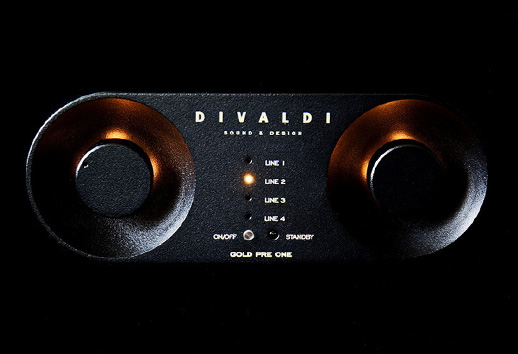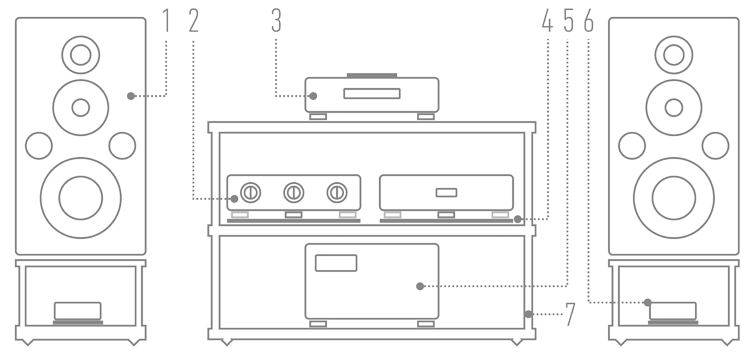|
INTEGRATED AMPLIFIER DIVALDI
Manufacturer: MEDIAM |

|
Review
text WOJCIECH PACUŁA |

|
No 254 July 1, 2025 |
|
˻ PREMIERE ˼
WE ALL, i.e., the people of the Divaldi brand and me, LIVE in the same city. The company's current headquarters is located no more than a fifteen-minute drive from my home. And the previous headquarters of Mediam, under which the Divaldi brand was established, was located even closer. I visited it once, and there was a lot to admire, as it was a very fine example of Polish Socialist Realism. The building is no longer there, replaced by a modern, quite pleasant, though ordinary office building. 
The full name of the brand is: Divaldi – Sound & Design (with the addition: Traditions Since 1984). And here is where I see the key role of another person. The name is not an overstatement, as the artistic design of its appliances, based on a distinctive shape with semicircular sides, is unique. No wonder, then, that in 2017 it received the prestigious iF Product Design Award, the following year confirmed by another honor, the A' Design Award and Competition, to which in 2020 was added the Stalowy Laur Zwycięzcy (Eng. Winner's Steel Laurel). Not enough? Among just a few industrial products at the exhibition "Transformacje. Nowoczesność w III RP" (Eng. "Transformations. Modernity in the Third Polish Republic") at the National Museum in Krakow, there was a Divaldi headphone amplifier. | A few simple words with… WŁODZIMIERZ DUVAL GOLD INT ONE to finalny efekt ciężkiej prawie trzyletniej pracy i wielu kłótni pomiędzy nami konstruktorami. Właśnie z powodu różnić zdań docelowo powstają cztery urządzenia: przedwzmacniacz, wzmacniacz zintegrowany, przedwzmacniacz gramofonowy i końcówka mocy. Nową serię nazwaliśmy Gold i ten kolor i charakterystyczny kształt będą nam już towarzyszyć w kolejnych naszych konstrukcjach. 
⸜ Prototyp obudowy wzmacniacza Gold Int One • zdj. Divaldi The Gold Int One is the successor to the INT-02 model. Like the previous models, the amplifier was built as dual mono. The body of the amplifier is a reference to our previous devices, which were designed by the brilliant, award-winning Polish industrial form designer Piotr Jagiełłowicz. The electronics design is the fruit of the cooperation of a team of audiophiles, music, computer science, electronics, and music lovers: Wojtek Markowski, Jurek Sołtys and myself, under the leadership of Włodzimierz Duval. The most difficult part was the construction of the housing. In Polish conditions, finding a professional company and a mechanical designer is quite a challenge, and this took us the longest. Electronically, the amplifier had been ready for over two years… The Gold Int One differs from other amplifiers in terms of its A class operation with variable current saturation. This mode of operation ensures stable amplifier behavior at low, medium and high load levels. The amplifier uses a negative feedback loop board (Low Global NFB). This solution provides the function of free tracking of output signals, while not bringing the amplifier to the threshold of generating audible dynamic distortion. 
The amp features two independent transformers and power supply units (Dual Supply type) with a huge power reserve, with a total output of 1,000 watts, so that under varying current-to-load matching conditions it does not introduce dynamic distortion at higher output power levels. This is important because other class-A circuits usually have problems with instantaneous current output during critical transients. In addition, we separated the power supply for the voltage stage and for the current stage. I should add that the total capacitor bank is about 100,000 μF. 
⸜ A Gold Int One prototype, still in the making • photo by Divaldi The input stage uses isolating transformers, thanks to which the amplifier achieves better matching of signal transmission between devices of different types and brands. For volume control, we used an ALPS potentiometer backed by a servo motor. The XLR/RCA inputs are electronically switched with a set of high-end relays. The speaker outputs are switched by relays through an automated system controlling the power stage operation. The output transistors are manually selected. The heat sinks are made in an innovative horizontal arrangement, unparalleled by any other such design in the world. The heat sink is a hand-assembled aluminum plate stack to which a large copper element is mounted, to which, in turn, the control and power transistors are mounted. Such a solution ensures virtually ideal heat dissipation and operation of all key components in the same operating regime, which increases the resistance of the amplifier's parameters to temperature drift. WŁ ▌ The Gold Int One THE KRAKOW DIVALDI COMPANY'S AMPLIFIER is a large, sturdy unit. It measures 463 x 450 x 130 mm and weighs 30 kg. The device offers 90 W of power per channel at an 8-ohm load and 130 watts at 4 ohm. At instantaneous power consumption, these values rise to 180 and 250 watts, respectively. The manufacturer states that the device operates with minimal negative feedback. The device operates in a push-pull arrangement in “floating” class A. It was once best known from Krell amplifiers and achieved in circuits used since 1993, called Anticipation and Sustained Plateau by that company; their modern version is called iBias. These treatments were intended to combine the advantages of this class of operation of final amplifiers and lower power consumption typical of class A/B. This, in turn, allowed for the reduction of power supplies, heat sinks and chassis – the most expensive design elements of any audio device. In “ordinary” class A, transistors work in such a way that their maximum resting current, or bias, is reached at all times when the transistors are on, regardless of the level of the input signal. Since current flows through them at all times, they heat up extremely and they need to be cooled intensively. That's why, as Duncan Taylor, author of the article Krell: Class A, All The Way, notes that the maximum amount of heat is dissipated at all times, and amplifiers of this type "appear to be mostly made of heat sink fins"; more → HERE. The Int One is an amplifier operating in “floating” class A, which means that the heat sinks can be smaller than if it were classic class A. While this used to be irrelevant, what is important in modern times is that it is much more eco-friendly class of operation than A, or even A/B. Class D beats all others in terms of performance, but has its own limitations. At the same time, it is a “pure” integrated amplifier, very classic, offering only line analog inputs. There are four inputs of this type, on both RCA and XLR sockets. In each pair, both inputs are active. The amplifier has an unbalanced design, so we have desymmetrising transformers after the XLR inputs, as in studio and stage products. The output consists of two pairs of speaker sockets. The manufacturer decided early on that the artistic design of its products would be sophisticated and unlike most other devices of this type on the market. The modification he proposed seemed simple and resulted in an unexpectedly interesting shape. Instead of straight side walls, something like a half-circle was made. This worked well in the small devices with which the company started, headphone amplifiers and phono preamplifiers, but in such large units as the amplifier under test something else had to be added. The first attempt was made with the INT-01 model. This is how the manufacturer described it:
These horizontal fins in the Int One are assembled from gold-anodized aluminum plates. They look great but are extremely cumbersome to manufacture. In the INT-01 version that preceded this device, the heat sinks were classic, milled. What we get now looks much better. The Neutrik input sockets and the nice gold-plated German WBT speaker sockets also look good. Let me add that the person responsible for the artistic design of Divaldi devices is Piotr Jegiełłowicz from the Jagiellowicz Design company, who cooperates with Divaldi. He has won numerous awards, including the Red Dot in 2015, 2018 and 2022, the If Design Award in 2016 and 2017, and the A' Award Design in 2023. In his bio, he writes:
The front of the device is minimalistic. Here we have only two knobs: input change and volume level, and a standby button. Between the knobs are white LEDs indicating the selected input, and the “sleep” button is illuminated in red. It really looks good. My only reservation is that the position of the volume knob is not very visible. It is coupled to a classic potentiometer, so it has a start and an end, but no graduation on the circumference. And then there is the remote control. That is - there is supposed to be. The one I received is plastic, and while it controls well, it is artistically no match for the amplifier. There are already some prototypes, but turning them into a final product has appeared more difficult than expected. ▌ THE LISTENING SESSION THE WAY WE LISTENED • The Divaldi Gold Int One integrated amplifier was tested in the “High Fidelity” reference system. It was compared to the two-part reference amplifier, i.e., an Ayon Audio Spheris Evo preamp and a Soulution 710 solid-state power amplifier. During the test, the device stood on its feet on the top carbon shelf of a Finite Elemente Pagode Edition Mk II table. 
During the test, I used the Ayon Audio CD-35 HF Edition SACD player and a Lumin T3 file player both as analog and digital sources. The signal between the SACD player and the amplifier was sent via a Crystal Cable Absolute Dream RCA interconnect, and from the file player it was sent via a Siltech Master Crown cable; both interconnects were unbalanced. The amplifier was powered by a Harmonix X-DC350M2R Improved-Version cable, and signal to the speakers was supplied by a Crystal Cable Da Vinci speaker cable. Divaldi Int One drove the Harbeth M40.1 speakers. » ALBUMS USED IN THE TEST ⸜ a selection
⸜ TOMMY DORSEY, Masterpieces 15, EPM 158342, „Jazz Archives”, CD ⸜ 1995. YOU DON'T HAVE TO BE AN EXPERT to immediately notice that the Divaldi amplifier has its own “agenda”. Everything in its sound is refined, worked out and derived. But this does not translate into mechanically copying the signal from the signal source onto the current needed to drive the speakers. As it seems, this is to modify it in such a way that, while maintaining standards for neutrality and “appropriateness,” it conveys the designers' view of how to recreate the emotions contained in music at home. 
The abovementioned agenda is all about smoothing the sound. , conducting it in such a way that there are no burrs and bumps in it. The closest reference for this type of a musical message would be the term “tube-like”. However, it would not be entirely accurate. It would simply be an evocation of a stereotype without specifying it. Only combined with “analog” and “vintage” would it give quite a sensible description of what I heard when listening to this amplifier in my reference system. |
So, we get smoothness and softness, as well as a slight preference of the midrange, rather in its lower ranges than above 1 kHz. These are good choices, maybe even very good ones. It's the type of sound I like and appreciate. And that's because it combines here, in the Divaldi amplifier, with precision and compactness. When TOMMY DORSEY played with his orchestra in the recording ˻ 1 ˺ I’m Getting Sentimental Over You, I instantly caught that “outlook” of his on the musical material. There was nothing in the sound that would bother me, nothing distracted me from the music, nor did it verge on shrillness. Recorded on October 18, 1935, the material, transferred from a shellac record, could play that way after all. Subsequent tracks included in the collection with the greatest hits of this trombonist, composer and leader of swing orchestras are even more strongly based on the midrange, and they too were not overexposed or overheated. In the sense that even when in ˻ 4 ˺ Song of India the trumpets play strongly, they do not “jump” in front of the mix, do not bother us. 
As I say, it was extremely pleasant sound. However, it was not too pleasant and it had much of the feistiness and sound attack which we know from live performances. You see, recreating music at home is a kind of art. It is not the same as what happens when playing live, or even as what happened in the studio. It is re-creation, or, literally, ‘creating anew’ (the same is true of ‘reproduction’, or ‘producing anew’). Using ingredients and elements from the real world, but still – from scratch. It's not a documentary, it's not a moment frozen in time, or whatever you want to call it there. The recording, using our experience and understanding of sound, is to shape the sound in such a way as to convey emotions and intentions, express beliefs. All this is included in the recording, more or less successfully, but always, and these are the most important ingredients of music. Sound as such, including its “accuracy ”, is subservient and is not something sacred and untouchable – it is the means, not the goal. That's why the kind of sound I got with the Int One amplifier appealed to me so much. And it's not just because the 1930s recordings sounded so pleasant, but also energetic, although that's an insanely difficult thing to achieve. After all, all other records will be shown in a similar way, regardless of their origin in time and space. All will be shown with a slight “letting go” of the attack, but also with its precise sustain and descent, which brings this device closer to another Polish design, the More Audio CS100 integrated amplifier, test → HERE. The twice-more-expensive amplifier from Krakow just does it all better and puts less emphasis on the lower midrange. It's not as full-bodied and saturated. For all its engaging sound it does not “let go” of the picture, does not lock the message into a “golden cage” of warm, smoothed sounds. Recordings of the kind that are included on KENNY BURRELL’S album On View At The Five Spot Cafe: The Complete Masters, played by me from the SHM-SACD version, will sound on the one hand open, and on the other hand pleasant. And perhaps it is the tension between what needs to be rendered to the recording and what we, the listeners, need, that is the greatest value in this device. For it brings balance between these two elements into the equation that the audio system in our room constitutes. And balance in audio is something excellent and perfectly desirable. With balanced recordings we will get great color, but also insight into the recording. It will be comfortable listening, but also attentive. | Our albums GYÖRGY KURTÁG Tacet 281, Compact Disc ⸜ 2025 
BORN 1926, GYÖRGY KURTÁG is a Hungarian composer, pianist and teacher, A member of Europe's most important musical bodies, he has been repeatedly decorated for his merits to music. As we read on Grove Music Online, his style has been compared to Bartók, Webern and, to some extent, Stravinsky. The album Complete Flute Music features all his flute compositions. It was recorded by the founder of the Tacet record label in a few days, in February and July 2024. The booklet, excellent when it comes to describing the music, lacked information about the recording itself, which should not happen to this type of release. More important, however, is the fact that Kurtág's music, offered by the Tacet label, is extremely refreshing. Please don't misunderstand me, Bach, Baroque, Renaissance and Romanticism - in that order - are my favorite types and periods in classical music. And yet, when I hear music of this class as contained on the album in question, I unwind. I had a similar experience at the May 9 concert at the Krakow Philharmonic, where Ivo Pogorelich was the special guest. Together with the local orchestra, he played in the second part of Chopin’s Piano Concerto No. 2 in F minor, Op. 21 and it was wonderful. But the strongest emotion, as I see it today, was stirred in me by Exodus for orchestra and tape by Krystyna Moszumańska-Nazar, preceded by the premiere of the short Gloria by Joanna Wnuk-Nazarowa, i.e., contemporary compositions. Listening to the tracks from the reviewed album, I had a similar sense of participating in a mystery play that was not easy and threw me out of balance, but also purified me. 
The sound on this album was captured from some distance. The flute is not a loud instrument, and one would imagine that the sound engineer would want to zoom in on it and enlarge it. This did not happen. So, all the instruments have an equal chance to appear. The decays are shown more strongly because of this, and the acoustics of the interior of the Luxembourg Philharmonic's Chamber Music Hall are much clearer than on many other recordings of this type. It's a clean and clear sound, yet somehow “patinated”. Whether this is due to the use of tube microphones or other treatments – I don't know. I do know, however, that the sound is perfect. ● » Sound quality: 9/10 → TACET.de IN RECORDINGS in which the balance is shifted toward the attack of the sound, as on the aforementioned Tommy Dorsey album, or as on THE BEATLES releases with a remaster dating back to 2009, the sound remains a bit brighter, but it will not be rewound in such a way as to make it unsuitable for listening. The remaster in question – released on 09/09/2009, by the way – was prepared by Allan Rouse and Guy Massey at Abbey Road. At the time, so to speak, it was a big step forward from older editions. Precision, resolution, clarity – everything was many times better. 
In retrospect and from the perspective of Giles Martin's remixes, however, it is clear that it was a problematic remaster. Simply put – it was too bright and too hard. However, the Divaldi Int One amplifier handles even such material very well. The device showed the steel, strong strings of an acoustic guitar in ˻ 13 ˺ Mother Nature’s Son, attacking piano tones and equally bright vocals in ˻ 14 ˺ Hey Bulldog clearly, but did not exaggerate in doing so. The Divaldi amplifier tries to keep all sound components on an equal level. It's fast, dynamic and has a widely extended bandwidth. But you can't do everything equally well, so when it's necessary to choose between the lesser of two evils - it chooses. When I played ˻ 1 ˺ Meat on a Stick by Karen Marie Ørsted, Danish artist known as MØ, the quite bright recording saturated with very low, poorly differentiated bass, sounded bright in manner, with clearly audible noise. It was neither muffled or warmed up sound. But there was also no artificial pumping of the bass or treble. In the same way, by the way, in the very cool club remix of The Final Countdown 2025 by EUROPE, made by DAVID GUETTA and HYPATON. It was energetic sound with flair. I haven't mentioned it yet, but this is a good time: the amplifier from Cracow is not, in fact, “tube-like” in the sense that it does not emulate the sound of this type of devices. So, in dense blues music, as in ROBIN TROWER’S ˻ 2 ˺ One Go Around, with strong percussion plates, they were sonorous and strong, without a hint of rounding. ▌ Conclusions The DIVADI INT ONE is not a typical “warming” or “smoothing” amplifier. Yes, it does something in the midrange and upper bass by which we perceive the sound in comfortable conditions. However, there is less emphasis here than one would expect. I'd say this has to do with strong treble handling and extended bass. There's also very good dynamics, which made the big drum hits in Snake Bit, a track announcing CODY JINKS' new album, pump the air through my room. At the same time, the amp does not exaggerate stereophony – and there has not yet been an opportunity to mention it. It shows events rather on the axis, quite deep into the stage. It doesn't pump up the stage, but rather embeds it in the listening room. And it does it all together, without separating the sound into individual features, sections or bands. At the same time, it's a great looking, very nicely made amplifier. Just nice, that's important, because we live in a certain environment and it's important that this environment is a good one. The Int One is just that. Krakow rules! :) ▌ THE DESIGN AS IT HAS ALREADY BEEN SAID, the Divaldi amplifier has an unusual body – instead of flat side panels it has rounded ones. Therefore, although it's a large device, it doesn't give an overwhelming impression. This is also helped by the gold elements that make up the complex heat sinks. Instead of being cast, they are assembled from flat elements forming a characteristic horizontal ridge and vertical cooling holes. The whole device stands on four aluminum feet. FRONT AND REAR • The front of the device is made of tempered tinted glass. This panel is bolted to a really rigid aluminum chassis. The appearance of the unit is minimalist, but also nice – it's not at all that less is automatically better. Here we have two small knobs – input and volume level change – recessed into an aluminum element in the front panel. The latter, unfortunately, doesn't have a very visible bar to indicate position; inputs are indicated by white LEDs. There are also buttons to change inputs and a red-lit standby button. The rear is very conveniently laid out. Neutrik sockets are used here, both XLR and RCA ones. The latter are mounted in formers shaped like XLR sockets, which simplifies the design work. Unlike usual, the left channel of the RCA inputs is not white, but green; a similar solution is also used by another Cracow company, Haiku-Audio; more → HERE. All the sockets are gold-plated and Teflon is used as the dielectric in them. There are also nice gold-plated WBT sockets. INSIDE • It is a dual mono device from an electrical perspective. Mechanically, this is not quite the case, as both channels share an input board and attenuator potentiometer. The output board with protection and relays is also shared by both channels. On the input board, where XLR sockets are soldered in and RCAs are connected by cables, you will find small relays. There are also small cans shielded with permalloy sheet, looking like desymmetrising transformers. And I guess that's what they are – the device does have XLR inputs, so the routed signal does indeed have common line interference suppressed, but the circuit is unbalanced. The tins have the Divaldi logo on them. 
The amp has a design with an attenuator on the input. A classic Japanese Alps rotary potentiometer is used here. After it, the signal goes to the power amplifier boards located on both sides of the amplifier. This is a solid-state circuit, with as many as six pairs of transistors operating in the push-pull mode, in floating class A. They are attached to copper plates, and these, in turn, are attached to an aluminum heat sink. The individual modules are connected by long interconnects. These are MC-100 microphone cables from the Polish company Red's Music, made of 99.96% OFC copper, shielded with a copper braided screen with added silver. The power supply unit looks amazing. There are two large toroidal transformers in it, separately for each channel, with separate secondary windings for the power amplifiers and preamplifier. They are bolted one on top of the other and insulated from each other and from the floor by thick rubber spacers. They are screwed not to the bottom panel, but to an additional rail stiffening the structure. Also mounted on separate rails are boards with rectifier bridges and capacitors - eight per channel, four for the preamplifier (separate bridges) and four for the power amplifier. ● ▌ Technical specifications (according to the manufacturer)
Class of operation: A 
THIS TEST HAS BEEN DESIGNED ACCORDING TO THE GUIDELINES adopted by the Association of International Audiophile Publications, an international audio press association concerned with ethical and professional standards in our industry, of which HIGH FIDELITY is a founding member. More about the association and its constituent titles → HERE. |

|
Reference system 2025 |
|
 1) Loudspeakers: HARBETH M40.1 |REVIEW| 2) Line preamplifier: AYON AUDIO Spheris III Linestage |REVIEW| 3) Super Audio CD Player: AYON AUDIO CD-35 HF Edition No. 01/50 |REVIEW| 4) Stands (loudspeakers): ACOUSTIC REVIVE (custom) |ABOUT| 5) Power amplifier: SOULUTION 710 6) Loudspeaker filter: SPEC REAL-SOUND PROCESSOR RSP-AZ9EX (prototype) |REVIEW| 7) Hi-Fi rack: Hi-Fi rack: finite elemente MASTER REFERENCE PAGODE EDITION Mk II, more → HERE |
|

|
Cables Analog interconnect SACD Player - Line preamplifier: SILTECH Triple Crown (1 m) |ABOUT|» ANALOG INTERCONNECT Line preamplifier → Power amplifier: Siltech ROYAL SINLGE CROWN RCA; review → HERE Speaker cable: SILTECH Triple Crown (2.5 m) |ABOUT| |

|
AC Power Power cable | Mains Power Distribution Block - SACD Player: SILTECH Triple CrownPower (2 m) |ARTICLE| » POWER CABLE Mains Power Distribution Block → Line preamplifier: Acoustic Revive ABSOLUTE-POWER CORD, review → HERE » POWER CABLE Mains Power Distribution Block → Power amplifier: Acoustic Revive ABSOLUTE-POWER CORD, review → HERE Power cable | Power Receptacle - Mains Power Distribution Block: ACROLINK Mexcel 7N-PC9500 (2 m) |ARTICLE| Power Receptacle: Acoustic Revive RTP-4eu ULTIMATE |REVIEW| » ANTI-VIBRATION PLATFORM under Acoustic Revive RTP-4eu ULTIMATE: Graphite Audio CLASSIC 100 ULTRA, review → HERE Power Supply Conditioner: Acoustic Revive RPC-1 |REVIEW| Power Supply Conditioner: Acoustic Revive RAS-14 Triple-C |REVIEW| Passive filter EMI/RFI: VERICTUM Block |REVIEW| |

|
Anti-vibration Speaker stands: ACOUSTIC REVIVE (custom)Hi-Fi rack: finite elemente MASTER REFERENCE PAGODE EDITION Mk II, more → HERE Anti-vibration platforms: ACOUSTIC REVIVE RAF-48H |ARTICLE| » ANTI-VIBRATIONAL FEET: |

|
Analogue Phono preamplifier: Phono cartridges:
Clamp: PATHE WINGS Titanium PW-Ti 770 | Limited Edition Record mats:
|

|
Headphones » HEADPHONE AMPLIFIER: Leben CS-600X, review → HEREHeadphones: Headphone Cables: Forza AudioWorks NOIR HYBRID HPC |
main page | archive | contact | kts
© 2009 HighFidelity, design by PikselStudio,
projektowanie stron www: Indecity
























